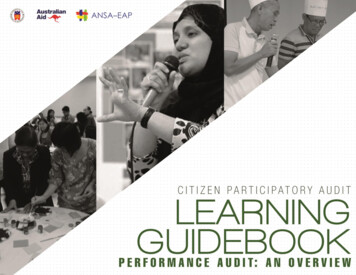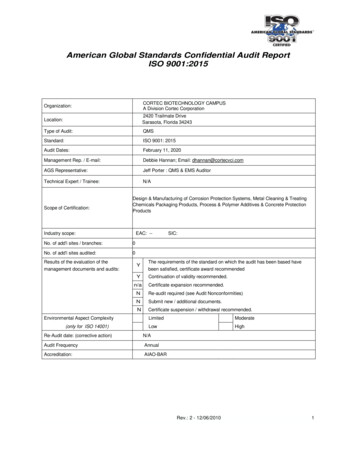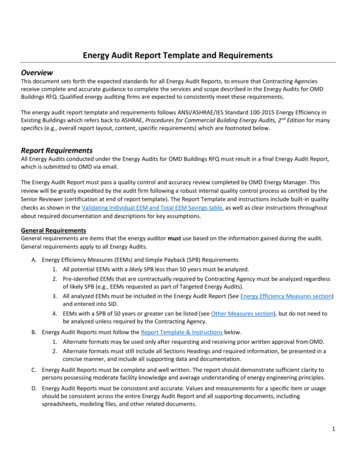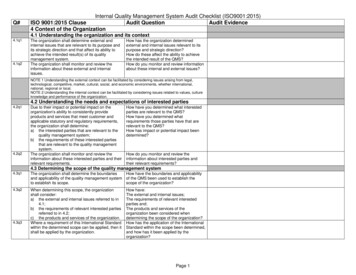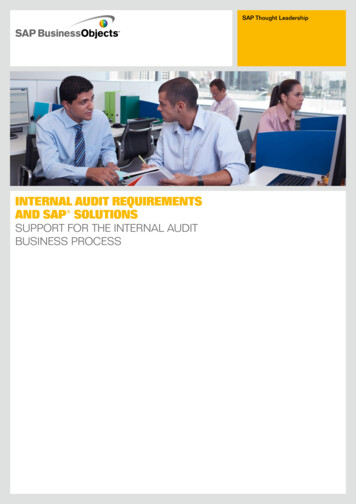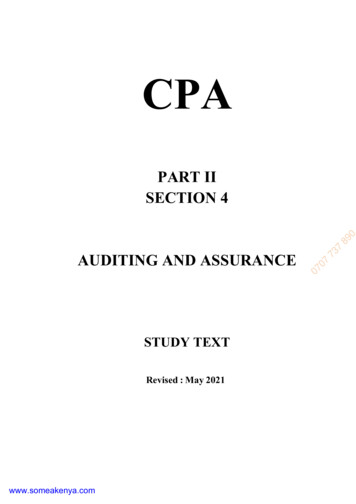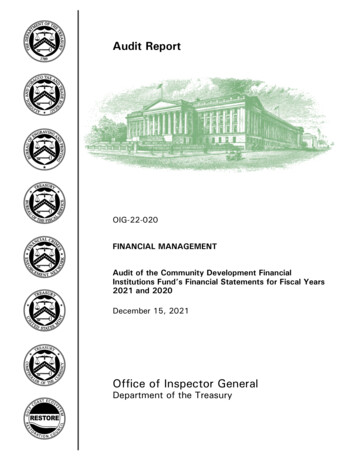
Transcription
Audit ReportOIG-22-020FINANCIAL MANAGEMENTAudit of the Community Development FinancialInstitutions Fund’s Financial Statements for Fiscal Years2021 and 2020December 15, 2021Office of Inspector GeneralDepartment of the Treasury
This Page Intentionally Left Blank
DEPARTMENT OF THE TREASURYW ASHINGTON, D.C. 20220December 15, 2021OFFICE OFINSPECTOR GENERALMEMORANDUM FOR JODIE HARRIS, DIRECTORCOMMUNITY DEVELOPMENT FINANCIALINSTITUTIONS FUNDFROM:Ade Bankole /s/Acting Director, Financial Statement AuditsSUBJECT:Audit of the Community Development Financial InstitutionsFund’s Financial Statements for Fiscal Years 2021 and 2020We hereby transmit the attached subject report. Under a contract monitored by ouroffice, KPMG LLP (KPMG), a certified independent public accounting firm, auditedthe financial statements of the Community Development Financial Institutions(CDFI) Fund as of September 30, 2021 and 2020, and for the years then ended.The contract required that the audit be performed in accordance with U.S.generally accepted government auditing standards, Office of Management andBudget Bulletin No. 21-04, Audit Requirements for Federal Financial Statements,and the Government Accountability Office/Council of the Inspectors General onIntegrity and Efficiency, Financial Audit Manual.In its audit of the CDFI Fund, KPMG found the financial statements were fairly presented, in all material respects, inaccordance with U.S. generally accepted accounting principles;no deficiencies in internal control over financial reporting that are consideredmaterial weaknesses; andno instances of reportable noncompliance with laws, regulations, contracts,and grant agreements tested.In connection with the contract, we reviewed KPMG’s report and relateddocumentation and inquired of its representatives. Our review, as differentiatedfrom an audit performed in accordance with U.S. generally accepted governmentauditing standards, was not intended to enable us to express, and we do notexpress, an opinion on the CDFI Fund’s financial statements or conclusions aboutthe effectiveness of internal control or compliance with laws and regulations.KPMG is responsible for the attached auditors’ report dated December 15, 2021,and the conclusions expressed therein. However, our review disclosed no instances
Page 2where KPMG did not comply, in all material respects, with U.S. generally acceptedgovernment auditing standards.If you wish to discuss this report, please contact me at (202) 927-5329, or amember of your staff may contact Catherine Yi, Audit Manager, FinancialStatement Audits, at (202) 927-5591.Attachment
AGENCY FINANCIAL REPORTFISCAL YEAR 2021Community Development Financial Institutions FundU.S. Department of the Treasury
This page has been intentionally left blank.2The content on this page is unaudited. Please see the accompanying auditor’s report.
TABLE OF CONTENTSMessage from the Director . . . . . . . . . . . . . . . . . . . . . . . . . . . . . . . . . . . . . . . . . . . . . . . . . . . . . . . . . . 5Overview . . . . . . . . . . . . . . . . . . . . . . . . . . . . . . . . . . . . . . . . . . . . . . . . . . . . . . . . . . . . . . . . . . . . . . . . . 9Program Discussion and Analysis . . . . . . . . . . . . . . . . . . . . . . . . . . . . . . . . . . . . . . . . . . . . . . . . . . . . . 19Bank Enterprise Award Program . . . . . . . . . . . . . . . . . . . . . . . . . . . . . . . . . . . . . . . . . . . . . . . 19Capital Magnet Fund . . . . . . . . . . . . . . . . . . . . . . . . . . . . . . . . . . . . . . . . . . . . . . . . . . . . . . . . 23CDFI Bond Guarantee Program . . . . . . . . . . . . . . . . . . . . . . . . . . . . . . . . . . . . . . . . . . . . . . . . 27CDFI Program . . . . . . . . . . . . . . . . . . . . . . . . . . . . . . . . . . . . . . . . . . . . . . . . . . . . . . . . . . . . . . 30CDFI Rapid Response Program . . . . . . . . . . . . . . . . . . . . . . . . . . . . . . . . . . . . . . . . . . . . . . . . 38Economic Mobility Corps . . . . . . . . . . . . . . . . . . . . . . . . . . . . . . . . . . . . . . . . . . . . . . . . . . . . . 41Native Initiatives . . . . . . . . . . . . . . . . . . . . . . . . . . . . . . . . . . . . . . . . . . . . . . . . . . . . . . . . . . . . 43New Markets Tax Credit Program . . . . . . . . . . . . . . . . . . . . . . . . . . . . . . . . . . . . . . . . . . . . . . 46Small Dollar Loan Program . . . . . . . . . . . . . . . . . . . . . . . . . . . . . . . . . . . . . . . . . . . . . . . . . . . 50Administrative Discussion and Analysis . . . . . . . . . . . . . . . . . . . . . . . . . . . . . . . . . . . . . . . . . . . . . . . 54Status of Financial Management . . . . . . . . . . . . . . . . . . . . . . . . . . . . . . . . . . . . . . . . . . . . . . . . . . . . . 58Independent Auditors’ Report . . . . . . . . . . . . . . . . . . . . . . . . . . . . . . . . . . . . . . . . . . . . . . . . . . . . . . . 66Financial Statement and Notes . . . . . . . . . . . . . . . . . . . . . . . . . . . . . . . . . . . . . . . . . . . . . . . . . . . . . . 70Appendix: Glossary of Acronyms . . . . . . . . . . . . . . . . . . . . . . . . . . . . . . . . . . . . . . . . . . . . . . . . . . . . . 943The content on this page is unaudited. Please see the accompanying auditor’s report.
Notes:Capitalized terms used but not defined in this document have the meanings as defined in the CDFIFund's authorizing statute, applicable program regulations, or applicable notice of availability.Numerals with decimal units are shown to one decimal place and are rounded to the nearesttenth. For example, 1.24 million is rounded down to 1.2 million, and 1.25 is rounded up to 1.3million.4The content on this page is unaudited. Please see the accompanying auditor’s report.
MESSAGE FROM THE DIRECTORI am pleased to present the fiscal year (FY) 2021 Agency Financial Report for the U.S. Departmentof the Treasury’s Community Development Financial Institutions Fund (CDFI Fund).Since its inception in 1994, the CDFI Fund has provided more than 5.1 billion through a variety ofmonetary award programs and 66.0 billion in tax credits through the New Markets Tax CreditProgram, and has guaranteed more than 1.8 billion in bonds through the CDFI Bond GuaranteeProgram, all to increase the impact of Community Development Financial Institutions (CDFIs) andother community development organizations in economically distressed and underservedcommunities. During this time, the CDFI Fund has helped build the capacity of more than 1,200Certified CDFIs, which are located in all 50 states as well as in the District of Columbia, Guam, andPuerto Rico.In FY 2021 alone, the CDFI Fund continued to build on this strong history of performance byproviding nearly 1.5 billion 1 in monetary awards and loans, committing to guarantee 100.0million in bonds, and allocating 5.0 billion in New Markets Tax Credits.CDFI Fund award recipients have successfully leveraged billions in private sector investment tocreate jobs, build affordable housing, build essential community facilities, provide financialcounseling, and invest in neighborhood revitalization initiatives—all in distressed andunderserved communities lacking access to traditional lending or banking institutions.The requests for the CDFI Fund’s awards continued to exceed the supply of resources for nearlyall programs in FY 2021, demonstrating strong applicant demand.FY 2021 CDFI Fund Programs - Program DemandAwardsProgramRequestedAvailableBank Enterprise Award Program 2N/A 26.0 millionCapital Magnet Fund 3N/A 380.0 millionCDFI Bond Guarantee Program 575.0 million 500.0 millionCDFI Program - Base-Financial Assistance and TechnicalAssistance 391.6 million 140.2 millionCDFI Program and NACA Program - Disability FundsFinancial Assistance 10.9 million 6.0 millionThis includes program rounds that were opened in FY 2020 and awarded in FY 2021The FY 2021 round of the Bank Enterprise Award Program opened in October 2021, and the application deadline is in December 2021.3The FY 2021 round of the Capital Magnet Fund opened in September 2021, and the application deadline is in November 2021.125The content on this page is unaudited. Please see the accompanying auditor’s report.
CDFI Program and NACA Program - Healthy Food FinancingInitiative-Financial Assistance 76.6 million 23.0 millionCDFI Program and NACA Program - Persistent PovertyCounty-Financial Assistance 60.1 million 20.4 million 2.9 billion 1.3 billionNative American CDFI Assistance Program (NACA Program)– Base Financial Assistance and Technical Assistance 26.1 million 14.9 millionNew Markets Tax Credit Program 4 15.1 billion 5.0 billionSmall Dollar Loan Program 26.3 million 13.5 millionCDFI Rapid Response ProgramIn FY 2021, the CDFI Fund undertook several key administrative and program initiatives tomaximize its impact, efficiency, and accessibility. These included: Deploying more than 1.2 billion in awards through the CDFI Rapid Response Program(CDFI RRP)—authorized by the Consolidated Appropriations Act of 2021 (P.L. 116260)—to 863 CDFIs to help communities recover from the economic effects of theCOVID-19 pandemic. This was the most grants ever awarded by the CDFI Fund in asingle program application round. It was also the quickest program round everadministered by the CDFI Fund; CDFI RRP moved from opening to application reviewand evaluation to award announcement in less than four months. Announcing in February 2021 over 175.0 million in Capital Magnet Fund (CMF)awards to 48 organizations under the FY 2020 round of the program. This was thelargest amount of funding ever awarded under the program. However, the FY 2021round of the program, which opened in September 2021, will more than double thisamount and award up to 380.0 million in funding. The CDFI Fund expects toannounce the awards in spring 2022. Collaborating with AmeriCorps to make the inaugural round of grants under the FY2021 round of the Economic Mobility Corps (EMC). Three organizations received atotal of more than 2.5 million to place 156 AmeriCorps service members in CDFIs fortwo years. In addition, 13% of EMC service members will be serving in PersistentPoverty Counties. Awarding more than 10.0 million in grants to CDFIs under the inaugural round of theSmall Dollar Loan Program (SDL Program). Authorized by the Dodd-Frank Wall StreetReform and Consumer Protection Act (P.L. 111-203), the SDL Program is intended tohelp unbanked and underbanked populations build credit, access safe, affordablecapital, and gain greater access to the mainstream financial system. CDFIs may use the4Numbers reflect the calendar year (CY) 2020 round of the program, which opened on September 22, 2020. The CDFI Fund awarded allocationson September 1, 2021.6The content on this page is unaudited. Please see the accompanying auditor’s report.
grants for Loan Loss Reserves and Technical Assistance that will enable them toestablish and maintain small-dollar loan programs. Continuing to support investment in Persistent Poverty Counties through targetedassistance provided by the Bank Enterprise Award Program, CDFI Program, and NativeAmerican CDFI Assistance Program. In the last fiscal year, CDFI Program awardrecipients have invested or lent 4.3 billion in PPCs, which is approximately 17 % ofthe total amount of CDFI Program awards that award recipients have invested or lent.The ongoing pandemic and resulting economic disruptions have created a challengingenvironment for the CDFI Fund’s staff as well as for the nationwide network of CDFIs, CommunityDevelopment Entities, and mission-driven, community-based organizations. Despite thechallenges, FY 2021 was a year of significant progress in the work to support underservedcommunities across the country.The accomplishments outlined in this report would not have been possible without the dedicatedefforts of the CDFIs and community-based organizations that take part in our programs. The CDFIFund’s achievements over the past year would have been wholly impossible were it not for thehard work, dedicated service, and professionalism of the CDFI Fund staff—to whom I amexceptionally grateful.Jodie HarrisDirectorCommunity Development Financial Institutions FundDecember 15, 20217The content on this page is unaudited. Please see the accompanying auditor’s report.
This page has been intentionally left blank.8The content on this page is unaudited. Please see the accompanying auditor’s report.
OVERVIEWThe Community Development Financial Institutions FundThe Creation of the CDFI FundEstablished by the Riegle Community Development and Regulatory Improvement Act of 1994(Riegle Act; P.L. 103-325), the Community Development Financial Institutions Fund (CDFI Fund)has worked for more than a quarter of a century to generate economic opportunity in placeswhere opportunity is needed most.People and communities with limited access to financial services and products lack the importanttools they need to save for the future, build credit, buy a home, start a business, and developaffordable housing and community facilities. As a result, they have fewer opportunities to growand thrive and fewer opportunities to join America’s economic mainstream.The CDFI Fund’s VisionAn America in which all people and communities have access to the investment capital andfinancial services they need to prosper.The CDFI Fund’s MissionTo expand economic opportunity for underserved people and communities by supporting thegrowth and capacity of a national network of community development lenders, investors, andfinancial service providers.The Work of the CDFI FundThe CDFI Fund’s role is to generate economic opportunity in underserved low-incomecommunities by expanding access to credit, capital, and financial services. It accomplishes this byproviding capital through the following active programs in FY 2021: Bank Enterprise Award Program (BEA Program) – Provides monetary awards to federallyinsured banks and thrifts that demonstrate increased lending, investment, and serviceactivities in the most economically distressed communities and/or in CDFIs Capital Magnet Fund (CMF) – Provides awards to CDFIs and nonprofit affordable housingorganizations for the development, preservation, rehabilitation, and purchase ofaffordable housing and for related economic development in low-income communities CDFI Bond Guarantee Program – Serves as a source of long-term, low-cost capital forCDFIs by guaranteeing bonds issued to support CDFIs that make investments for eligiblecommunity or economic development purposes9The content on this page is unaudited. Please see the accompanying auditor’s report.
Community Development Financial Institutions Program (CDFI Program) – ProvidesFinancial Assistance and Technical Assistance awards to help Certified and Emerging CDFIssustain and expand their services and build their technical capacity. The program alsoincludes:-Healthy Food Financing Initiative (HFFI) – Provides Financial Assistance awards toCertified CDFIs that invest in businesses that provide healthy food options, such asgrocery stores, farmers’ markets, bodegas, food co-ops, and urban farms-Disability Funds-Financial Assistance (DF-FA) – Provides Financial Assistance awardsto Certified CDFIs that wish to expand their financing activities and services to benefitpersons with disabilities-Persistent Poverty County-Financial Assistance (PPC-FA) – Provides FinancialAssistance awards to Certified CDFIs that provide Financial Products in PersistentPoverty Counties (PPCs) CDFI Rapid Response Program (CDFI RRP) – A pandemic recovery program consisting of asingle application round that was conducted in FY 2021 and provided grants to enableCDFIs to deliver emergency support to distressed and underserved communities sufferingfrom the economic hardships created by the COVID-19 pandemic Economic Mobility Corps (EMC) – A joint initiative of the CDFI Fund and AmeriCorps thatplaces full-time national service members in Certified CDFIs to enhance their capacity toprovide financial education and financial counseling Native Initiatives – Includes the Native American CDFI Assistance Program (NACAProgram), which provides Financial Assistance and Technical Assistance awards to buildthe capacity of CDFIs serving Native American, Alaska Native, and Native Hawaiiancommunities New Markets Tax Credit Program (NMTC Program) – Awards tax credit allocationauthority to Certified Community Development Entities, enabling them to attractinvestment from the private sector and invest the funds in low-income communities Small Dollar Loan Program (SDL Program) – Provides grants to help Certified CDFIs offerfair and affordable small dollar loan products in communities that are underserved bymainstream financial institutionsThese awards have leveraged billions of dollars in private sector investment. They have increasedthe impact of CDFIs, CDEs, and other community-based development organizations by expandingtheir capacity to deliver the credit, capital, and financial services that generate new economicopportunities in underserved communities.10The content on this page is unaudited. Please see the accompanying auditor’s report.
What is a CDFI?CDFIs are mission-driven financial institutions that specialize in increasing access to financialservices in underserved and low-income areas. They possess a keen sensitivity to the needs oflocal residents and businesses, and their work reflects a bottom-up, rather than a top-down,approach to community investment and revitalization.Today, there are 1,271 CDFIs serving urban, rural, and Native communities throughout the UnitedStates. CDFIs are found in all 50 states, the District of Columbia, Guam, and Puerto Rico. Theybridge diverse public and private sector interests to serve people and places that traditionalfinancial institutions usually do not. CDFIs provide: loans to businesses and projects that otherwise would find it difficult to qualify forfinancing; safe, affordable banking services that otherwise would not be available in the community; loan rates and terms that are more flexible than those offered by traditional lenders; and development services—such as business planning, credit counseling, and homebuyereducation—to help their borrowers use credit effectively and build financial strength.As a result, CDFIs support the creation of small businesses and local jobs and the development ofaffordable housing, community facilities, and schools—all in places where economic opportunityis needed most.Types of CDFIsThere are four basic types of CDFIs:1. Community development banks, thrifts, and depository institution holding companies –Regulated, for-profit corporations that provide basic retail banking services as well as capitalto rebuild economically distressed communities through targeted lending and investment2. Community development credit unions – Regulated, member-owned cooperatives thatpromote ownership of assets and savings and provide affordable loans and retail financialservices3. Community development loan funds – Typically nonprofits that provide high-quality loansand development services to microenterprises, small businesses, affordable housingdevelopers, and community service organizations11The content on this page is unaudited. Please see the accompanying auditor’s report.
4. Community development venture capital funds – For-profit and nonprofit organizations thatprovide equity and debt-with-equity features to businesses in distressed communitiesAlthough each type of CDFI provides different products and services to different types ofcustomers, they all share a common goal of revitalizing low-income communities.Types of certified CDFIs(Percentage by type of 1,271 Certified CDFIs as of September 30, 2021)1%11%566 Loan Funds387 Credit Unions13%45%168 Banks or Thrifts134 Depository InstitutionHolding Companies16 Venture Capital Funds30%CDFI CertificationFor an organization to be eligible for most of the CDFI Fund’s programs, it is required to becertified as a CDFI. To qualify for certification, it must meet seven eligibility requirements:1. Be a legal entity at the time of application2. Have a primary mission of promoting community development3. Primarily serve one or more target markets4. Be an insured depository institution or otherwise have the provision of financial productsand services as its predominant business activity5. Provide development services (such as technical assistance or counseling) in conjunctionwith its financing activity6. Maintain accountability to its target market12The content on this page is unaudited. Please see the accompanying auditor’s report.
7. Be a non-governmental entity nor be controlled by any governmental entitiesOnce a CDFI has been certified, it must submit an Annual Certification and Data Collection Report(ACR) to allow the CDFI Fund to assess whether the organization remains in compliance withcertification requirements and to monitor any changes in the organization’s financial and otherdata.The most recent ACR indicates that the CDFI industry has more than 151.8 billion in total assetsand that total liabilities are roughly 23.0 billion less than total assets ( 128.9 billion). Net worthfor the CDFI industry is slightly less than 21.3 billion. 5Asset Size of ACR Reporting CDFIs by Institution Type 6CDFI Institution TypeNSum of TotalAssets ( )Share of TotalAssets (%)Average of TotalAssets ( )Median of TotalAssets ( )Bank/Thrift109 38,855,251,30525.6% 356,470,195 252,696,000Credit Union223 92,702,624,93461.1% 415,706,838 106,029,258Loan Fund464 20,091,968,92713.2% 43,301,657 9,525,323Venture Capital Fund10 179,453,9630.1% 17,945,396 4,501,032Total806 151,829,299,129100.0% 188,373,820 28,223,453What is a CDE?A Community Development Entity (CDE) is a domestic corporation or partnership that serves as afinancial intermediary vehicle for the provision or purchase of loans, investments, or financialData from the 2020 ACR Summary Report (https://www.cdfifund.gov/node/1004981).The dollar amounts reported above are based on ACR data submitted for the 2020 reporting cycle by all certified CDFIs required to submit a 2020ACR. CDFIs certified in 2020 or later were not required to submit a 2020 ACR. The data universe consisted of 1,030 2020 ACR records in the CDFIFund ACR database as of July 8, 2021. After data cleaning standards were applied, final data analysis was conducted using the 2020 ACR records of881 certified CDFIs. Seventy-four holding companies were excluded from the analysis above to avoid double-counting since they were certifiedbased on activity of the certified affiliated bank CDFIs, and one CDFI did not complete the Total Assets section of the ACR.5613The content on this page is unaudited. Please see the accompanying auditor’s report.
counseling in low-income communities. Certification as a CDE allows organizations to participateeither directly or indirectly in the NMTC Program.The NMTC Program attracts investment capital to low-income communities by permittingindividual and corporate investors to receive a tax credit against their federal income taxes inexchange for making equity investments in CDEs. A CDE applies to the CDFI Fund to receive theauthority to allocate a specified dollar amount of tax credits. The CDE then offers the tax creditsto investors in exchange for their investments and uses those funds to make loans to or equityinvestments in qualified businesses in the community.Through the NMTC Program, CDEs support many type of businesses, including manufacturing,food, retail, housing, health care, technology, energy, education, and child care. Communitiesbenefit from the jobs created by these investments as well as from the community facilities andcommercial goods and services that the businesses provide.CDE CertificationIn addition to certifying CDFIs, the CDFI Fund certifies CDEs. To be certified as a CDE, anorganization must apply for certification and meet three eligibility requirements:1. Be a legal entity at the time of application2. Have a primary mission of serving low-income communities3. Be accountable, through representation on a governing board or advisory board, to theresidents of its targeted low-income communitiesWhen an organization is certified as a CDE, it is eligible to apply to participate in the NMTCProgram.The Operations of the CDFI FundThe CDFI Fund is a wholly-owned government corporation within the U.S. Department of theTreasury and performs a wide range of functions to ensure that it fulfills its mission.OrganizationThe organization chart below shows how the CDFI Fund is structured to best support the activeprograms it administered in FY 2021.14The content on this page is unaudited. Please see the accompanying auditor’s report.
Community Development Advisory BoardIn accordance with the Riegle Act, the CDFI Fund’s organization includes a CommunityDevelopment Advisory Board that advises the Director of the CDFI Fund on policies guiding theactivities of the CDFI Fund. The Advisory Board is required to meet at least once each year.The Advisory Board consists of 15 members: nine private citizens, who are appointed by thePresident, and six other members—the Secretaries of the Departments of Agriculture,Commerce, Housing and Urban Development, Interior, and Treasury and the Administrator of theSmall Business Administration or his or her designee. The nine private citizens include: two officers of existing CDFIs; two officers of insured depository institutions; two officers of national consumer or public interest organizations;15The content on this page is unaudited. Please see the accompanying auditor’s report.
two individuals with expertise in community development; and One individual with personal experience and specialized expertise in the unique lendingand community development issues of Indian tribes on Indian reservations.The Chair of the Advisory Board is elected from among the nine private citizens and also iselected by them.Appropriations and Sources of FundingCongress appropriates funding to the CDFI Fund each year. The appropriation consists of twotypes of funds:7 Program funds, which are used for financial assistance and technical assistance awards(such as grants, loans, deposits, and equity investments) and capacity building/trainingcontracts, can be spent over two fiscal years; and in the case of the Emergency SupportProgram 7, the funds have no expiration date Administrative funds, which are used to cover the costs to administer all of the CDFIFund’s programs, including the NMTC Program and the CDFI Bond Guarantee Program,must be spent during the fiscal year for which they are appropriatedThis program received appropriations in FY 2021 but there was not an active application round during the fiscal year.16The content on this page is unaudited. Please see the accompanying auditor’s report.
In FY 2021, Congress appropriated the CDFI Fund 270.0 million through the annualappropriations process. Congress also provided a supplemental appropriation of an additional 3.0 billion through the Consolidated Appropriations Act of 2021 (P.L. 116-260) to provideemergency support to CDFIs and communities responding to the COVID-19 pandemic.Congressional Appropriations(Amounts in Millions)FY 2021AppropriationsAmountFY 2020PercentAmountPercentAnnual Appropriations:-BEA Program 26.09.6% 25.09.5%-CDFI Program 188.0 869.6% 185.570.8%-Economic Mobility Corps 2.00.7% 2.00.8%-Native Initiatives 16.56.1% 16.06.1%-Small Dollar Loan Program 8.53.2% 5.01.9%-Administrative Cost 29.010.7% 28.510.9%Total Annual Appropriations 270.0100.0% 262.0100.%Supplemental Appropriations:-CDFI Rapid Response Program 9 1,250.041.7%-Emergency Support Program 1,750.058.3%Total Supplemental Appropriations 3,000.0100.0%Total Amounts Funded 3,270.0100.0%Less Amounts Not Obligated 10 1,964.5Total Funding Used 1,305.5 8.539.9% 11 253.596.8%Includes funding for Base-FA, TA, PPC-FA, DF-FA, and HFFI awards.The CDFI Rapid Response Program was a pandemic recovery program that was funded by Congress in FY 2021 for a single application round thatwas conducted in FY 2021.10In FY 2020, the CDFI Fund did not obligate 8.5 million, which included 1.1 million of the CDFI Program, 0.4 million of the Native Initiatives, 5.0 million of the Small Dollar Loan Program, and 2.0 million of the Economic Mobility Corps.In FY2021, the CDFI Fund did not obligate 1.964 billion, which included 167.7 million of the CDFI Program, 25.8 million of the Bank EnterpriseAward Program, 14.6 million of the Native Initiatives, 2.7 million of the Small Dollar Loan Program, 2.0 million of the Economic Mobility Corps,and 1.751 billion of the Emergency Support Program.11The percentage of total Annual Appropriations used (excluding Supplemental Appropriations) is 21.6%.8917The content on this page is unaudited. Please see the accompanying auditor’s report.
Appropriations include fiscal year budget authority, and the amount available in a given yearincludes any unobligated funds from the prior year 12 that may be carried over. Also, the annualappropriation includes authority to make loans and issueIt should be noted that the funding for the Capital Magnet Fund is not provided through theannual appropriations process. Instead, it comes from allocations made by two GovernmentSponsored Enterprises (GSEs), the Federal National Mortgage Association (Fannie Mae) and theFederal Home Loan Mortgage Corporation (Freddie Mac), on a mandatory basis, as authorized bythe Housing and Economic Recovery Act of 2008.Likewise, the NMTC Program is also not “funded” through the annual appropriation process.Authorization to allocate New Markets Tax Credits is provided through the Taxpayer Certaintyand Disaster Tax Relief Act of 2020 (P.L. 116-260). The CDFI Bond Guarantee Program is also not“funded” but is authorized by Congress through the annual appropriation process.Source
County-Financial Assistance 60.1 million 20.4 million CDFI Rapid Response Program 2.9 billion 1.3 billion Native American CDFI Assistance Program (NACA Program) - Base Financial Assistance and Technical Assistance 26.1 million 14.9 million New Markets Tax Credit Program4 15.1 billion 5.0 billion




